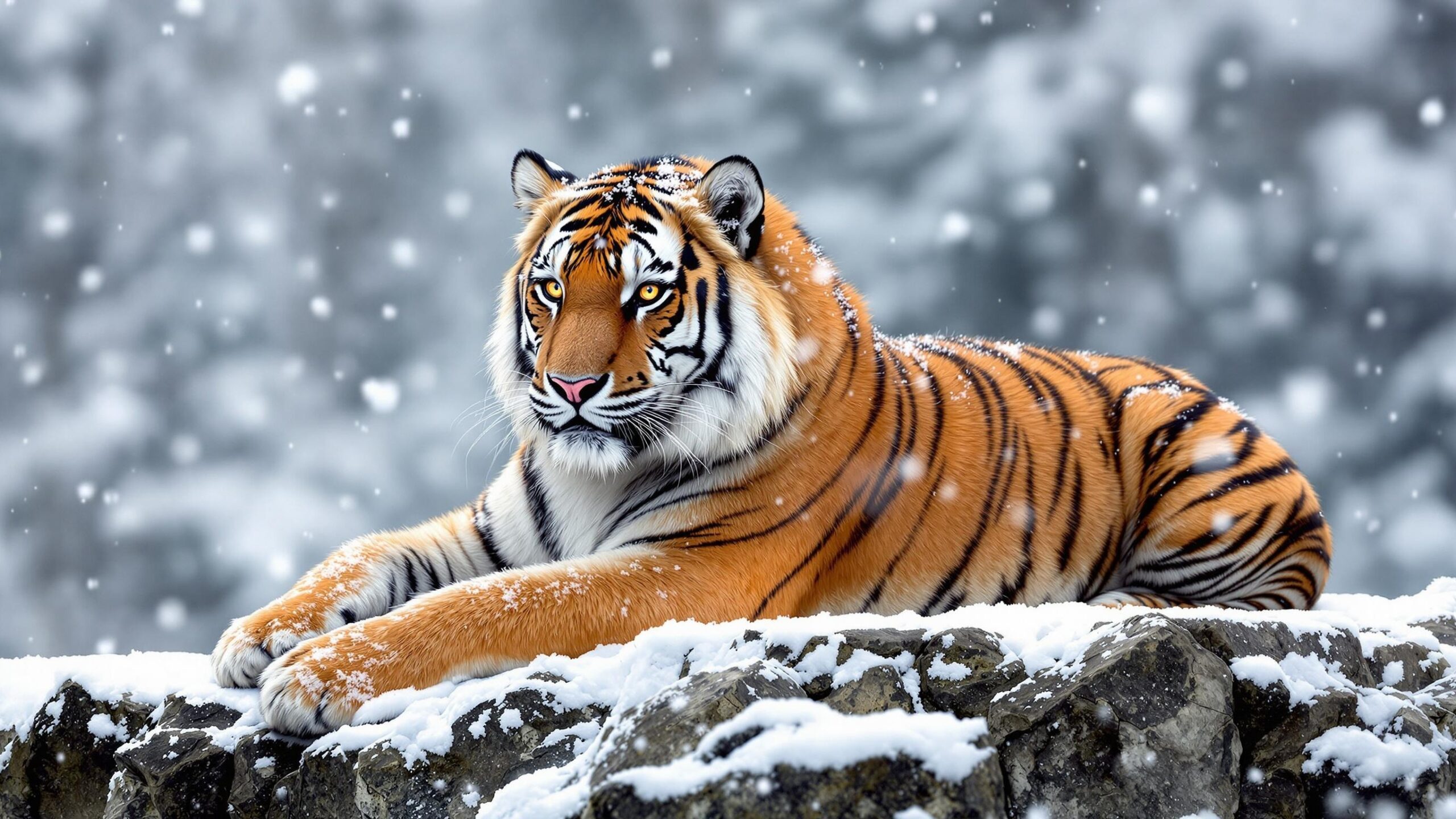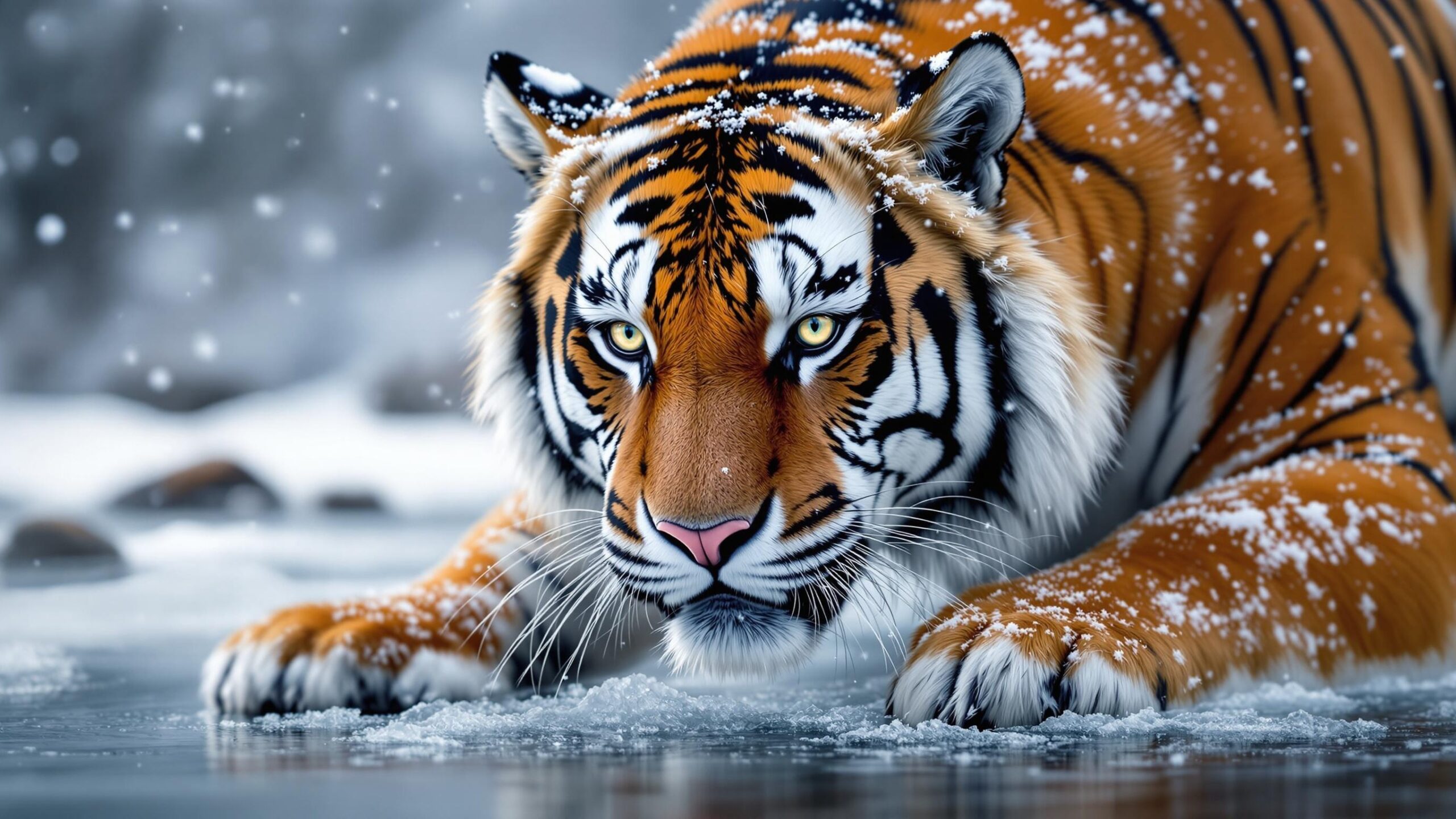Siberian Tiger: The Silent King of the Frozen North
The Siberian tiger, scientifically named Panthera tigris altaica, is the largest of all tiger subspecies and one of the most awe-inspiring predators to walk the Earth. Roaming the snowy forests and rugged mountains of eastern Russia, particularly the Russian Far East, this big cat embodies survival against the odds. It is a master of stealth, power, and endurance in a world of harsh climates and dwindling wilderness.
Known for its thick fur, massive size, and quiet grace, the Siberian tiger is more than just a beautiful creature—it’s a symbol of nature’s tenacity and a living relic of a wilder world. This article takes you deep into the realm of the Siberian tiger, exploring its biology, behavior, habitat, and cultural impact, while offering an insightful look at the efforts to protect one of the world’s most endangered and enigmatic predators.
Physical Characteristics of a Giant Predator
Siberian tigers are true giants among cats. Males can weigh up to 660 pounds and stretch over 10 feet from nose to tail, making them the largest cats in existence. Females are smaller, generally weighing around 300 to 370 pounds. These powerful animals are designed for both strength and endurance, with muscular bodies, large forelimbs, and immense paws that allow them to move silently through snow and dense underbrush.
Their fur is paler than that of Bengal tigers, appearing more golden-orange or even beige in winter, with widely spaced black stripes. This adaptation helps them blend into snowy and forested landscapes. Beneath that outer beauty lies a thick layer of insulating fat and a long, luxurious coat that allows the Siberian tiger to survive temperatures that often drop well below zero. One of the most distinct features of the Siberian tiger is the ruff of fur around its neck, which resembles a mane and offers additional warmth during the coldest months. Their large nasal passages also help warm incoming air, a crucial adaptation for life in extreme climates.
A Solitary Life in the Wild Forests of Asia
Siberian tigers inhabit a region far removed from the tropical forests most commonly associated with tigers. Their home lies in the boreal forests and mountainous terrain of the Russian Far East, particularly the Sikhote-Alin Mountains near the Sea of Japan. Smaller populations have historically roamed parts of China and North Korea, but the Russian taiga remains their stronghold.
These forests are thick with Korean pine, fir, spruce, and birch, and the undergrowth offers the perfect cover for a stalking tiger. The region’s isolation, low human density, and vast tracts of protected land have played a role in keeping this subspecies alive.
Siberian tigers are highly territorial and solitary, often claiming territories that range from 200 to 600 square miles depending on prey availability. Males generally maintain larger ranges that overlap with several females but not with other males. Each tiger will patrol its territory, using scent markings, scratch marks on trees, and vocalizations to communicate presence and deter rivals.
Silent Stalkers and Master Hunters
A Siberian tiger’s hunting strategy is a refined balance of stealth, patience, and explosive strength. They typically hunt at night, moving silently through the forest with practiced precision. These apex predators rely heavily on their sense of sight and hearing rather than smell. They prefer to ambush rather than chase, often creeping within 20 to 30 feet of their prey before launching a deadly pounce. Their diet includes large ungulates such as red deer, roe deer, sika deer, and wild boar. In leaner times, they may prey on smaller animals such as hares or badgers. A successful kill is often dragged to a secluded spot and consumed over several days. Tigers have even been known to cache their kills under leaves and snow, returning periodically to feed. Unlike many predators, tigers are not gluttons. A large meal may be followed by several days of fasting. Their hunting success rate is relatively low, requiring them to hunt often and travel vast distances in search of food.

Mating, Cubs, and the Cycle of Life
The reproductive cycle of the Siberian tiger is closely tied to its solitary nature and harsh environment. Tigers can mate at any time of year, though peak activity tends to occur during the winter months. Mating pairs will stay together for several days, during which they may copulate numerous times before separating. After a gestation period of approximately three and a half months, the female gives birth to two to four cubs in a hidden den, often located in a sheltered area such as a rocky cave or hollow tree. Cubs are born blind and completely dependent on their mother. For the first few weeks, she will leave them only briefly to hunt, and she remains fiercely protective.
By two to three months, the cubs begin to explore their surroundings. By six months, they start accompanying their mother on hunts, though they remain dependent for more than a year. Young tigers usually separate from their mother at 18 to 24 months, after which they seek their own territory—a perilous time when mortality rates are highest.
A Deep Intelligence and Complex Behavior
Siberian tigers, like all big cats, are highly intelligent animals. In captivity, they have demonstrated problem-solving abilities, long-term memory, and complex social cues. In the wild, their intelligence is often expressed in the form of adaptive behavior. They quickly learn and adjust to changes in prey movement, seasonal patterns, and even human encroachment. Communication among tigers is subtle but meaningful. They use a wide range of vocalizations including roars, growls, moans, chuffing, and hisses. Scent marking with urine, scat, and scratch marks serves as a chemical messaging system that conveys territory boundaries, reproductive status, and individual identity. Despite being solitary, Siberian tigers are not antisocial. Females with cubs are known to share kills and display affectionate behavior. Siblings may also remain together for extended periods after leaving their mother. These social nuances hint at a deeper level of emotional and cognitive development than once believed.
Cultural Reverence and Symbolic Power
The Siberian tiger holds a special place in the cultural mythology of the Russian Far East and neighboring regions. In indigenous Siberian beliefs, the tiger is often revered as a guardian spirit or a forest protector. It is both feared and respected, an animal of great spiritual significance. In modern Russia, the tiger has become a symbol of national pride and ecological identity. It appears in literature, films, folk art, and conservation campaigns. Its powerful image continues to inspire awe, drawing attention to the need for wilderness preservation. Globally, the Siberian tiger has captured imaginations as the epitome of wild beauty and raw power. From documentaries to animated films and corporate logos, it remains a cultural icon, serving as a bridge between human creativity and nature’s grandeur.
Conservation Status and Population Trends
The Siberian tiger was once perilously close to extinction. By the 1940s, its population had plummeted to fewer than 50 individuals due to unregulated hunting and habitat loss. In response, the Soviet Union enacted strict protections, banning tiger hunting and establishing nature reserves. Thanks to sustained conservation efforts, the population rebounded. Today, estimates suggest that around 500 to 600 Siberian tigers live in the wild, most of them in Russia’s protected Far Eastern forests. Though far from secure, this represents a remarkable recovery and a model of successful wildlife management.
Conservationists have employed a range of strategies to protect the tiger. Anti-poaching patrols, habitat corridors, radio-collar tracking, and international cooperation have all played key roles. The Amur Tiger Program, led by Russian authorities and supported by global NGOs, remains at the forefront of these efforts. Nevertheless, threats remain. Poaching, although reduced, still occurs—motivated by illegal trade in tiger parts used in traditional medicine. Logging and infrastructure development continue to chip away at vital tiger habitats. Climate change may also affect prey distribution and forest composition, introducing new long-term risks.

Siberian Tigers in Captivity and the Role of Zoos
Thousands of Siberian tigers exist in captivity around the world, where they are part of breeding programs, educational exhibits, and genetic research efforts. Accredited zoos, particularly those involved in species survival plans, work to maintain healthy and diverse gene pools that could potentially support reintroduction efforts if needed. Captive environments allow for close observation of tiger behavior, health, and reproduction, contributing to scientific knowledge that informs wild conservation. However, captivity is not without controversy. Poorly managed facilities can contribute to inbreeding, stress, and unethical trade. Responsible management and public education remain essential to ensuring that captivity serves conservation rather than exploitation. In the best facilities, Siberian tigers live in spacious, enriched enclosures that stimulate their natural behaviors. Visitors leave with a greater appreciation for this magnificent animal—and a deeper understanding of the fragile ecosystems it represents.
Differences from Other Tiger Subspecies
What makes the Siberian tiger distinct from its relatives like the Bengal, Malayan, or Sumatran tigers goes beyond mere geography. Physically, Siberian tigers are the largest, and their paler coloration and thicker fur reflect the demands of their northern habitat. They also have fewer and more widely spaced stripes, likely an adaptation for camouflage in snowy environments.
Behaviorally, Siberian tigers range over much larger territories due to the lower density of prey in their environment. Their lives are quieter and more solitary compared to tropical tigers that may encounter other individuals more frequently. Ecologically, the Siberian tiger is a keystone species in a unique biome—the boreal forest. It helps regulate herbivore populations and maintain the health of the ecosystem. Its survival ensures the preservation of a broader range of biodiversity in the Russian Far East, from birds and small mammals to ancient forest stands.
Famous Individuals and Field Stories
Over the years, certain Siberian tigers have become emblematic of their species’ struggle and survival. One of the most famous was “Zolushka,” a female cub found orphaned in the wild and rehabilitated by Russian conservationists. After being raised in a semi-wild enclosure, she was successfully released back into the wild and later gave birth to cubs—an unprecedented conservation success story. Scientists and rangers working in the Russian Far East have recorded incredible tales of Siberian tigers—encounters where tigers tracked humans silently for miles, stories of tigers overcoming injuries to survive, and examples of maternal courage and cunning. These stories, grounded in both science and myth, offer a glimpse into a world that is as mysterious as it is beautiful. They remind us that the tiger is more than a symbol—it is a real, living being that continues to thrive, survive, and surprise in the cold corners of our planet.
Why the Siberian Tiger Matters
The Siberian tiger’s survival is more than a conservation victory—it is a testament to the possibility of coexistence between humans and the natural world. As a top predator, its presence is vital to the balance of its ecosystem. As a cultural icon, it bridges past traditions with present awareness. As a living creature, it embodies the wild soul of the Earth.Protecting the Siberian tiger means protecting the forests it roams, the rivers it drinks from, and the prey it hunts. It means preserving ancient habitats not just for one species, but for the web of life that depends on it. And it means ensuring future generations can look into the amber eyes of this great beast and feel something primal stir—respect, wonder, and perhaps even responsibility.
A Final Glimpse into the Wilderness
To glimpse a Siberian tiger in the wild is a rare and extraordinary experience. Even a single pawprint in the snow, a flash of orange in the trees, or a distant roar is enough to ignite the imagination. I t reminds us that despite a world full of screens and cities, true wilderness still exists—and in that wilderness walks the largest cat on Earth. Let that image inspire not just admiration but action. The Siberian tiger’s fate is not sealed; it continues to walk a thin line between survival and oblivion. But with dedication, awareness, and collaboration, this silent king of the frozen north may yet continue its reign for generations to come.

